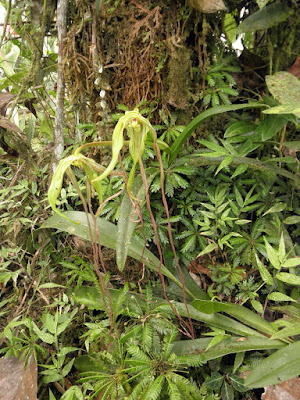Phragmipedium lindenii is native to Ecuador, Colombia and Venezuela. These plants are found on open savannas and under shrubs, tall ferns, tall trees, and on fallen logs, in rain forests...
Phragmipedium lindenii also called as Linden's Phragmipedium, Cypripedium caudatum var. lindenii, Cypripedium caudatum var. uropedium, Cypripedium lindenii, Paphiopedilum caudatum var. lindenii, Paphiopedilum lindenii, Phragmipedium caudatum var. lindenii, Phragmipedium lindenii, Selenipedium caudatum var. lindenii, Selenipedium lindenii, Uropedium lindenii, is a species of the genus Phragmipedium. This species was described by Robert Louis Dressler & Norris Hagan Williams in 1975.
IDENTIFY PHRAGMIPEDIUM LINDENII
Phragmipedium lindenii is native to Ecuador, Colombia and Venezuela. These plants are found on open savannas and under shrubs, tall ferns, tall trees, and on fallen logs, in rain forests at elevations of 1200 to 2850 meters.
It is a large sized, cold to warm growing lithophyte or terrestrial, which reaching a height of 30-46 cm, with no pseudobulbs, with imbricate, conduplicate leaf-bearing sheaths carrying ligulate, leathery, distichous, 3 to 4 pairs, basally imbricating, glabrous, dark green conduplicate below into the base, 41 cm long leaves.
Linden's Phragmipedium blooms in the late fall and early winter with long lasting, simultaneously opening flowers on a sub-erect, terminal, to 25 cm long, 1 to 3 flowered, racemose inflorescence that is just longer than the leaves and has a large leafy basal bract and several prominent tubular bracts. The flowers are almost white to yellowish-green, and the inner whorls, which have the shape of ribbons, are colored red. When the flower opens, the petals of the inner whorl are not fully formed and extend over several days. In most of the known forms, the lip is replaced by a third inner leaf, also in the shape of a ribbon. However, sometimes there are forms with a lip and these are very similar to Phragmipedium caudatum.
PHRAGMIPEDIUM LINDENII CARE AND CULTURE
Cultural information should only be used as a guide, and should be to be adapted to suit you. Your physical location; where you grow your plants, how much time you have to devote to their care, and many other factors, will need to be taken into account. Only then can you decide on the cultural methods that best suit you and your plants.
Light:
Phragmipedium lindenii needs a light level of 30000-40000 lux. Distributed light is recommended.
Temperature:
The average temperature of the day is 25-27 ° C, and the night 16-18 ° C, which gives a daily difference of 7-9 ° C.
Humidity:
Linden's Phragmipedium needs the humidity of 75-85% throughout the year.
Substrate, growing media and repotting:
Phragmipedium lindenii needs a quickly dry substrate but can retain some moisture and it is recommended to use chopped woody fern fibers. Repotting is best done after flowering, when new roots begin to grow.
Watering:
The precipitation pattern is wet throughout the year, with 2 periods of very heavy rainfall in spring and autumn. The plants should be constantly moist.
Fertilizer:
During the growing season, it is recommended every week or every 2 weeks apply 1/4-1/2 doses of fertilizer for orchids.
Rest period:
In winter, you can slightly reduce the amount of water, humidity and fertilization for Phragmipedium lindenii until new growth occurs in the spring when more watering is resumed.















COMMENTS